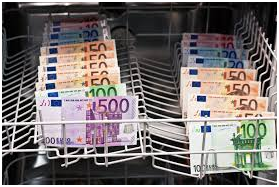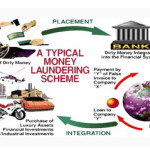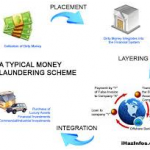The first stage in the washing cycle – Placement (video)

 Placement
Placement
Placement is the first stage of the money laundering process. It is the process of placing, through deposits or other means, unlawful cash proceeds into traditional financial institutions. At this stage cash derived from criminal activity is infused into the financial system. The placement makes the funds more liquid since by depositing cash into a bank account can be transfer and manipulated easier.
Why criminals need to place the cash into the financial system
When criminals are in physical possession of cash that can directly link them to predicate criminal conduct, they are at their most vulnerable. Such criminals need to place the cash into the financial system, usually through the use of bank accounts, in order to commence the laundering process. Possession of the proceeds of crime in the form of cash is risky in large quantities because it:
• provides a link to the predicate crime;
• is hard to explain away when detected by law enforcement or other government agencies;
• requires safe storage;
• is susceptible to theft;
• is exposed to deterioration (vermin, damp, fire and other types of damage);
• may go out of date if the issuing government releases new forms of currency;
• may raise questions when used in large sums to pay for other assets such as houses, cars, boats, shares etc.
Placement methods
The most common placement techniques are the following:
• Smurfing and structuring
• Disguised deposits
• Use of monetary instruments
• Inter-mingling
• Shell companies
• Assets purchases
• Casinos-Gambling
• Bulk movement
• Money Services and Currency Exchanges
• Value Tampering
• Redemption of life policy or similar investment
• Alternative remittance
• Electronic transfer
Structuring (“smurfing”): Smurfing is possibly the most commonly used money laundering method. It involves many individuals who deposit cash into bank accounts or buy bankdrafts in amounts under €10,000 to avoid the reporting threshold.
Cash from illegal sources is divided between many individuals (the”smurfs”) who make multiple deposits into multiple accounts at different financial institutions. In this way, money enters the financial system and is then available for layering. Suspicion is often avoided as it is difficult to detect any connection between the smurfs, deposits and accounts.
Structuring involves splitting transactions into separate amounts under EURO 10,000 to avoid the transaction reporting requirements. Many money launderers rely on this placement technique because numerous deposits can be made without triggering the cash reporting requirements. However, it can backfire if an attentive financial institution notices a pattern of deposits just under the reportable threshold. This can lead to reporting such activity to the regulatory authorities under the suspicious activity provisions of these instruments. Structuring is a criminal offence itself, as well as an indicator of other potentially illegal activity.
Disguised deposits: Launderers often divide large amounts of cash into a number of small transactions amounts, for example of less than €10,000 by, for instance:
a) Making several deposits into a single or multiple accounts on successive days;
b) Making several deposits into the same account at different branches of the same bank
c) Making deposits into a number of accounts (often opened by using false identities) at different branches of the same bank;
d) Making deposits into different accounts with the same or different banks and then consolidating the balances of the accounts into one account;
e) Depositing cash into accounts of third parties such as lawyers, real estate agents, brokers and security firms;
f) Paying other people (called ‘smurfs’) to deposit the money into their own accounts and then transfer the money to a single account controlled by the money launderer;
g) Depositing cash with the assistance of corrupt bank staff who themselves manipulate the deposits to make them appear as if they are below the reporting threshold.
Use of monetary instruments: Launderers purchase monetary instruments, such as money orders, postal orders and traveller’s cheques. In this way they convert cash into financial instruments for relatively small amounts, which are easily transportable, and then deposit them elsewhere.
Inter-mingling: Money launderers often attempt to conceal the origin of criminally derived cash by mixing it with legitimate generated cash. They do so by using the services of lawful business enterprises. They may take over or invest in businesses that customarily handle a high cash transaction volume in order to mix the illicit proceeds with those of the legitimate business. Criminals may also purchase businesses that commonly receive cash payments, including restaurants, bars, night clubs, hotels, currency exchange shops, fuel stations, taxi services and vending machine companies. They will then insert criminal funds as false revenue mixed with income that would not otherwise be sufficient to sustain a legitimate business. These types of businesses are called ‘front businesses’ because they disguise the money launderer’s criminal operations.
Shell companies: A cheaper but riskier alternative is to establish what is known as a “Shell company”. This is a company that is incorporated on paper, but that does not own any physical assets and does not genuinely trade. The launderer opens an account in the name of the shell company and deposits criminally derived cash into it, representing the money as the profits of the shell company.
Assets purchases: Launderers may also use the cash proceeds of their criminal activities to buy assets. Virtually any asset will suffice for this purpose, although real estate, gold and precious metals, art, motor cars and antiques are popular items because they hold substantial value and are readily tradeable.
Following acquisition, these assets may then be sold and converted into bank transfers for the value, thereby bringing the proceeds of crime into the financial system. The risks with this approach arise from:
• cash reporting obligations that might directly apply;
• records that the seller may keep of the assets it sells;
• questions that may be asked by the seller’s bank regarding the large cash deposit that it makes following the sale.
Money launderers will search for sellers of such assets who want cash for their own reasons (for example tax evasion).
Also money launderers may use these items but will distance themselves by having them registered or purchased in an associate’s name.
Some countries have reporting requirements that oblige all businesses to file an Internal Revenue Service’s form for all goods and services purchased with cash of an amount in excess of USD10,000. Also the Third EU Directive requires all member states to incorporate ‘purveyors of high value commodities’ within their national AML strategies in respect of sales involving cash of more than €15,000. Purchases made over the Internet, arranged through sites such as Ebay and settled in cash through face-to-face meetings, are obviously vulnerable to being used to launder criminal property.
Use of casinos-Gambling: Casinos are used both to place and integrate dirty money. Cash may be taken to a casino to purchase chips which can then be redeemed for a casino cheque. The money launderer then deposits the check into a bank account, claiming it as gambling winnings and can easily be used to justify unusual spikes in income. This income can then be deposited into a legitimate bank account.
Other types of gambling techniques include:
• Claiming gaming machine prizes/payouts whilst not being the legitimate prize-winner (that is, not the player who has accumulated the subject credits or turnover).
• Exchanging cash for or purchased gaming prizes/payouts from legitimate prize winners.
• Exchanging cash for prize-winning cheques. This may be coordinated by ‘spotters’ who look for winners. They target problem gamblers who may want their winnings straight away and are willing to receive 95% of the face value of the ticket.
• Exchanging cash for prize-winning gaming machine tickets.
• Negotiating cash loans to other members/patrons for the purposes of gambling.
• Engaging in activity that may otherwise be considered illegal or contrary to responsible gambling activities. For example, some machines pay a 98% return. Patrons may work in groups on networked machines, cover as many betting options as possible and win as a group.
Bulk movement: Physically smuggling cash and monetary instruments, such as money orders and cheques into another jurisdiction, usually overseas, and depositing (placement) it in a financial institution, such as an offshore bank, with greater bank secrecy or less rigorous money laundering enforcement.
Money launderers use their illicit cash to purchase small but of high value items such as diamonds, gold or even collector’s stamps and other expensive goods. These items are physically easy to smuggle as well as relatively easy to reconvert into cash at the point of destination.
Bulk shipments of illegally obtained funds (or goods acquired with the funds) are smuggled across borders concealed in private vehicles, commercial trucks and air and maritime cargo. They may also be carried by couriers travelling on commercial airlines, trains and buses. Further, they can also be sent through parcel delivery and express mail services.
Money Services and Currency Exchanges: Money services and currency exchanges provide a service that enables individuals to exchange foreign currency that can then be transported out of the country. Money can also be wired to accounts in other countries. Money launderers may purchase foreign money with illegal funds through foreign currency exchanges. Other services offered by these businesses include the sale of money orders, cashiers cheques, and travellers cheques.
Value Tampering: Money launderers may look for property owners who agree to sell their property, on paper, at a price below its actual value and then accept the difference of the purchase price “under the table”. In this way, the launderer can, for example, purchase a $2 million dollar property for $1 million, while secretly passing the balance to the seller. After holding the property for a period of time, the launderer then sells it for its true value of $2 million.
Redemption of life policy or similar investment: This method involves the launderer in placing funds with an insurance company and sometime later encashing the property (or borrowing against it) so that a cheque from the insurance company has the appearance of emanating from a legitimate source. (placement and integration at the same time).
‘Single premium’ insurance products can be particularly vulnerable. They involve a single payment ‘up-front’ and the ability to immediately purchase a fully paid instrument. To a money launderer, these products are attractive because they:
• involve a one-time payment;
• have a cash surrender value;
• may be transferable;
Insurance is sold through many channels. Any of these channels may be tapped by money launderers to place illegal funds.
Alternative remittance: ‘Alternative remittance’ is a funds transfer service usually provided within ethnic community groups. Such services accept cash, cheques or monetary instruments in one location and pay an equivalent amount to a beneficiary in another location. In some communities this form of money transfer is commonly known as hawala, hundi, chuyen tien, yok song geum, or pera padala. These are mostly person to person transfer systems that involve minimal documentation, if any. A brief description of the process is as follows:
An Individual A brings a large sum of illegal cash to an alternative remittance provider and he specifies the identity and location of the recipient. The alternative remittance provider arranges for the funds to be sent overseas. Individual A may or may not receive a receipt for the transaction.
The recipient, Individual B, goes to the counterpart of the alternative remittance provider in the overseas location. The counterpart provides the specified amount of cash (less any transfer charges) to Individual B. Again, no documents may be involved.
Alternative remittance is also known as underground or parallel banking. There are large networks of these systems in operation around the world. The larger networks are prevalent in South East Asia, Latin America, North America and the Middle East. Alternative remittance systems predate the mainstream banking system and have been used in China and India for centuries. After the terrorist attacks of 11 September 2001, these systems have come under intense scrutiny as avenues for the transfer of money by terrorist groups.
These services are used to transfer both legal and illegal money. In many countries, the Western-style banking systems are under developed. Alternative remittance services have been called upon to ordinary people, workers, travellers and immigrants to transfer legal funds to their families and business counterparts. However, these alternative systems can also be used by tax evaders, terrorists, money launderers and other criminals.
Although alternative remittance systems enable the successful transfer of funds across countries or regions, this is just the first step in placing the money. The recipients of the funds have to find ways of placing these funds in financial institutions at their end.
Electronic transfer: This method involves the transfer of money through electronic payment systems that do not require sending funds through formal bank accounts. This method is also known as wire transfer.
Electronic transfers can be compared to alternative remittances in that both are person-to-person transfers that do not require sending funds through the formal banking system.
Criminals make use of the electronic financial system because it enables the transfer of large denominations of money instantly to offshore jurisdictions. This speedy disbursement of funds to and between foreign jurisdictions makes the transactions difficult to investigate and trace back to the source.
A brief description of the process is as follows:
Individual A takes cash to an electronic funds transfer agency ABC Ltd and requests a transfer of funds to Individual B in the Country C.
Individual B goes to the ABC Ltd branch in the Country C, presents his identification and collects the funds.
Watch video below:
Video source: antimoneylaunderingvideos.com
Find more: Contributing Authors





























